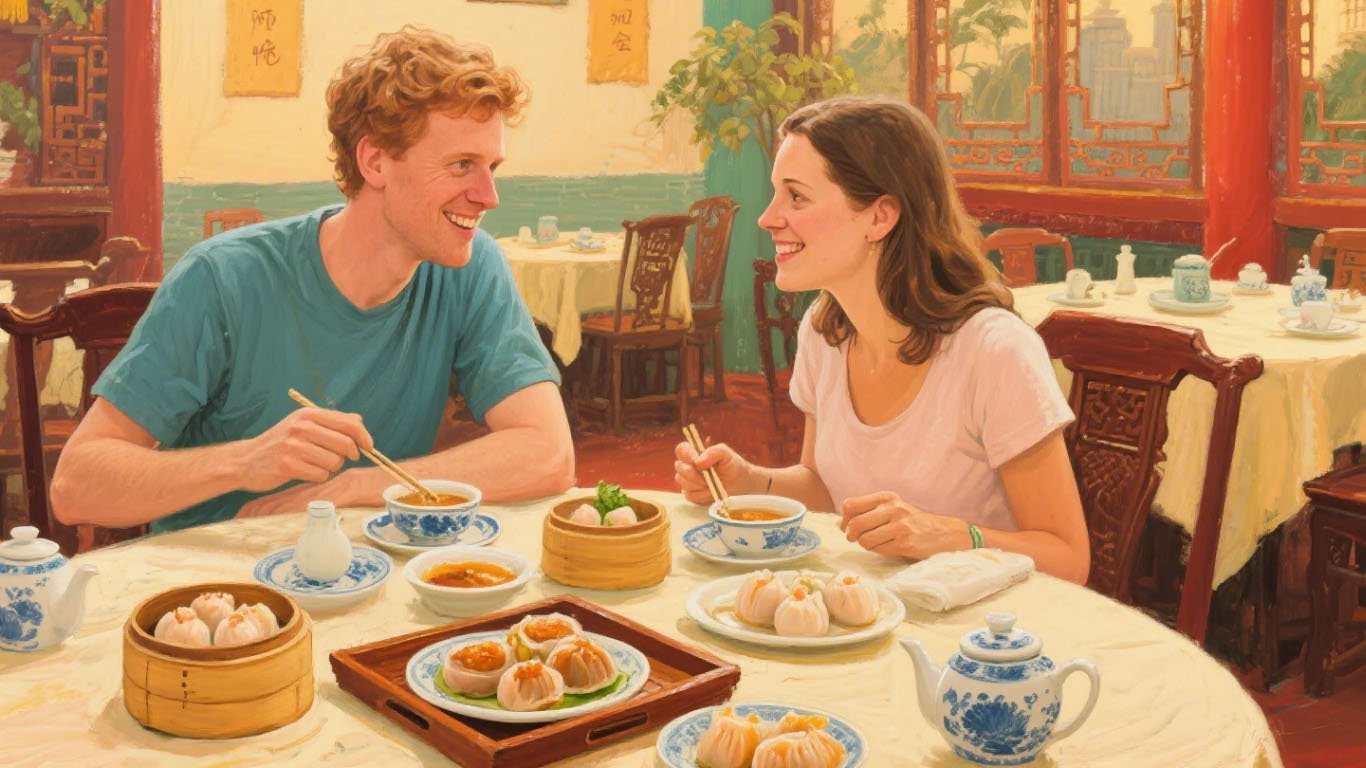Western perceptions of China often miss its vibrant culinary traditions. Alan and Shannon, a British couple, dive into a Cantonese breakfast in Guangz
Western perceptions of China often miss its vibrant culinary traditions. Alan and Shannon, a British couple, dive into a Cantonese breakfast in Guangzhou, experiencing yumcha—a tea-drinking and dim sum ritual. This article, crafted for allwinchina.org, captures their adventure, highlighting the flavors, traditions, and value of this cultural gem to inspire global visitors.
The Yumcha Experience: Tea and Dim Sum
At 8:00 a.m., Alan and Shannon set out for yumcha, meaning “drinking tea” in Cantonese. They walked 45 minutes to a local Guangzhou tea house, a spot bustling with elderly patrons, reflecting its deep-rooted tradition. “It’s mostly older people here,” Alan notes, unsure if younger generations embrace it. The lively atmosphere and dim sum photos on the walls set the stage for their first Cantonese breakfast.
Navigating the Menu: A Culinary Adventure
The couple ordered a set menu, skipping chicken feet for extra dim sum. “We don’t like chicken feet,” Shannon says, requesting more dumplings. The menu lacked prices, adding an element of surprise. They observed no one used sauces, unlike their usual habit of pairing food with multiple dips. “The skill is in the cooking,” Alan explains, noting Cantonese cuisine emphasizes fresh ingredients over heavy seasonings.
Cultural Rituals: Tea and Etiquette
A Cantonese tradition caught their attention: the first tea pour sterilizes chopsticks. Shannon, skeptical, trusts the restaurant’s hygiene but follows along. “I don’t think we need to sterilize,” she laughs. Another rule emerged— the youngest at the table pours tea for others. Shannon, the youngest, fills Alan’s cup, who taps the table twice to say “thank you,” a local custom. They also heard dim sum should include four steamed and one fried dish, though their knowledge came from an Instagram reel.
Tasting Dim Sum: Flavors and Textures
The couple savored various dim sum, starting with char siu bao, barbecued pork buns inspired by Guangzhou’s love for char siu. “It’s soft, with a sweet glaze,” Alan says, his fingerprints indenting the bun. The sweet bun paired perfectly with the savory pork, delivering an “incredible” flavor. Next, they tried har gow, translucent shrimp dumplings from Guangzhou’s tea houses over a century ago. “The shrimp is big and crunchy, the casing so light,” Shannon marvels, surprised by the delicate texture.
They sampled siu mai, open-topped dumplings with pork, shrimp, and mushrooms, originating from northern China but a Cantonese staple. “It’s heavy, packed with meat,” Alan notes, contrasting its density with lighter dumplings. A unique dish, resembling “Chinese sushi,” featured a pink outer layer, crispy center, and shrimp, served with sweet chili, sesame, and soy dips. “It’s like an inside-out spring roll,” Shannon exclaims, deeming it her favorite for its silky coating and balanced flavors.
Surprising Value: A Feast for Less
After nearly four hours of eating and socializing, the couple was stuffed. “I thought these tiny dumplings wouldn’t fill us,” Alan admits, struggling to finish. They left two char siu bao and two siu mai, overwhelmed by the portions. The bill shocked them—just over £12 (150 RMB). “Insane value for the freshest pork and shrimp,” Alan says. A set menu sign suggested £7, but their customized order was still a bargain.
Kitchen Peek: Craftsmanship on Display
Before leaving, they peeked into the kitchen, spotting char siu, duck, goose, and chicken. Chefs crafted dim sum and rolled egg noodles on a massive chow pan. “The portions are huge,” Shannon says, tempted despite being full. The open kitchen showcased the skill behind each dish, reinforcing the freshness that defined their meal.
Finding the Tea House: Tech Makes It Easy
China’s tech infrastructure aided their discovery. Using a local map app, they searched “tea house” and found this spot. “Everything’s in Chinese, but you can translate to English,” Alan explains. The ease of navigation reflects China’s improving digital landscape, making exploration accessible for foreigners.
A Cultural Gem: Highly Recommended
Alan and Shannon rate their yumcha experience a “10/10” for taste and value. “If you’re in Guangdong, don’t miss a Cantonese breakfast,” they urge. The tea house’s social vibe, where people chat for hours, left them satisfied but ready for a coffee break at McDonald’s. They invite feedback on whether they found a truly traditional tea house or if better options exist.
Conclusion: A Taste of Authentic China
Alan and Shannon’s yumcha adventure reveals China’s rich culinary heritage. From light har gow to hearty siu mai, Cantonese breakfast blends tradition and flavor. Affordable, fresh, and welcoming, it’s a must-try for visitors. allwinchina.org encourages you to explore China’s cultural treasures firsthand.
We Tried Real Cantonese Dim Sum for the First Time 🇨🇳
Author: Alan & Shannon



COMMENTS